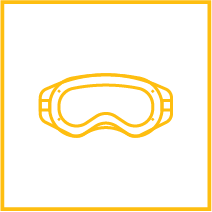USC PPE Standards
The standards outline the minimum requirements for personal attire and PPE usage in areas where hazardous materials are present (e.g., labs, chemical storage rooms). All research personnel should become familiar with the standard prior to beginning work in the lab. For information on appropriate footwear, consult the PPE: Shoes Fact Sheet.
NOTE: PPE may need to worn by personnel in the vicinity of work being done, and not just by those actually doing the work. This includes personnel sitting at writing desks within the lab; see PPE at Desk in the Laboratory Guide Sheet for additional details.
PPE should not be worn in public areas such as offices, restrooms, breakrooms, elevators, or outdoors.
PIs have ultimate responsibility for ensuring the USC PPE Standards are followed within their research groups.
- How to Select Proper PPE
- Lab Coat Selection – Which Lab Coat is Right for Me?
- Selection of Eye and Face Protection
- Glove Selection
- Respirators
- PPE Maintenance
How to Select Proper PPE
EH&S provides labs with a basic risk assessment in the form of the Laboratory Hazard Assessment Tool (LHAT). This document outlines the PPE that must be worn to mitigate risks associated with identified hazards in the workspace.
Remember:
- Update the LHAT whenever significant changes take place in the nature of the lab work.
- Share the LHAT with all members of the research group.
- Supplement the LHAT with more specific risk assessments carried out with the research group, if needed. Laboratory personnel should conservatively assess the potential hazards associated with their work during the planning stages, and should identify any additional appropriate PPE requirements accordingly.

Lab Coat Selection – Which Lab Coat is Right for Me?

Selection of appropriate lab coats should be in accordance with the potential hazards being encountered. Refer to the PPE: Lab Coats Fact Sheet for assistance in selecting the proper lab coat type.
The five types of lab coats that can be purchased for lab use are:
- Flame Resistant, Nomex
- Flame Resistant, Nomex – Chem Splash
- Flame Resistant Treated Cotton
- Standard Cotton, 100%
- Fluid Resistant (barrier)
Lab coats may be purchased through Medico via eMarket. See details at the Lab Coat Services website. Loaner lab coats (Nomex and Flame Resistant Treated Cotton) are available to researchers for short term use (e.g., pending arrival of new lab coat purchases). See Lab Coat Loaner Guide Sheet for details.
Selection of Eye and Face Protection
Selection of appropriate eye/face protection should be in accordance with the ANSI/ISEA Z87.1-2015 guidelines, the Chemical Hygiene Plan, EH&S Fact Sheets/Guide Sheets, and best practice (e.g., Prudent Practices in the Laboratory). Selection should be commensurate with written hazard assessments (e.g., LHAT). The International Safety Equipment Association (ISEA) provides an authoritative free downloadable guide to the selection and use of eye/face protection.
The most common types of eye and face protection include:
- Safety glasses – Minimum standard when working with hazardous materials.
- Goggles – Completely seals the eye area and are appropriate for handling splash hazards and working with particularly hazardous substances and corrosive materials.
- Face shields – Must be worn in conjunction with another form of eye protection (e.g., safety glasses, goggles).
- Laser safety eyewear – Must be worn to protect against intense concentrations of light produced by lasers and shall be matched to the power and wavelength of the laser. Refer to the Laser Safety Manual for more information.
- UV eye protection – Must be worn to protect against UV radiation (both long and short wavelength). To be permissible, eyewear shall be stamped with the ANSI Z87.1-1989 UV certification.
Avoid using the following eyewear when working with hazardous materials:
- Eyeglasses/sunglasses that do not meet ANSI/ISEA Z87.1-2015 are NOT approved safety eyewear.
- Contact lenses may NOT be worn or handled (e.g., removing or putting on contact lenses) where eye hazards exist due to the possibility of them exacerbating eye damage per Cal-OSHA regulations.
For more detailed information about eye protection, please refer to the Eye Protection Fact Sheet, the Goggle/Face Shield for Splash Hazards Fact Sheet, Laser Safety Eyewear Fact Sheet, and Ultraviolet Radiation Fact Sheet.

Glove Selection

Glove selection can be more complex than selection of lab coats or eye protection. It is essential that personnel consult manufacturers’ information on the applicability and limitations of specific gloves prior to beginning laboratory work. Please consult the chemical SDS and CHP for further information on proper glove selection.
Proper Glove Use:
- Change disposable gloves regularly.
- Do not re-use disposable gloves.
- Do not touch door handles/elevator buttons while wearing laboratory gloves.
- Do not handle chemicals without wearing appropriate gloves.
Respirators
Respiratory protection is complex, and is subject to stringent regulatory requirements. For safety and regulatory reasons, personnel at USC are not permitted to use respirators unless enrolled in the EH&S Respiratory Protection Program. Unauthorized respirators in labs will be cited as a safety finding during safety and PPE inspections.
PPE Maintenance
Proper PPE maintenance is commonplace and necessary in an active lab setting to assure adequate protection against exposure to chemical, biological, and radioactive hazards. The PPE Maintenance web page offers best practices and useful tips for keeping PPE in good condition and long-lasting.